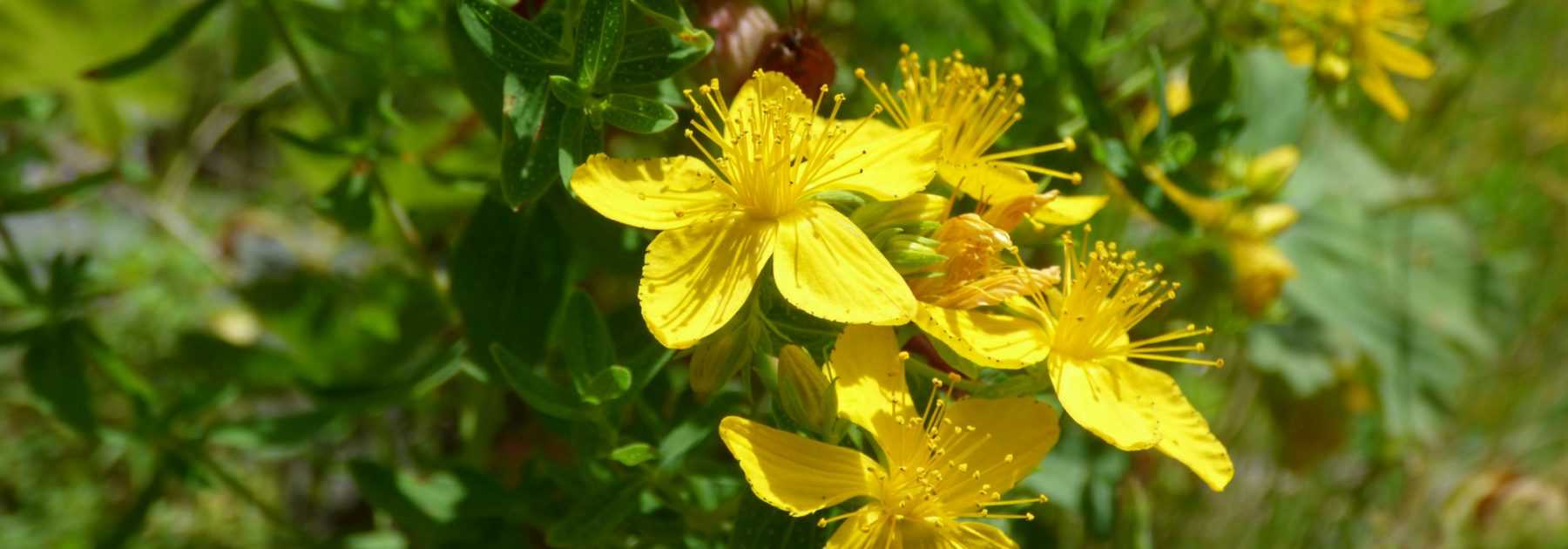
Hypericum, St John's Wort: Planting, Pruning, Care
Contents
Hypericum, in a nutshell
- St John’s Wort bushes are very easy to grow, hardy, robust and fast-growing, perfect for filling neglected spaces
- They charm with both their long-lasting bright yellow flowering, enhanced by a large cluster of stamens, and their dense, full foliage
- Their habit ranges from all-terrain ground cover to vigorous bushy shrubs
- They have multiple uses from embankments to flowerbed borders, rockeries or refined terraces
- The dense, healthy foliage, evergreen or deciduous, varies greatly in both shape and colour
- In some species like inodorum, colourful berries accompany the flowering
Our expert's word
St John’s Wort, commonly known as Hypericum, are popular small bushes in our gardens due to their incredible ease of cultivation. From the ground-covering Hypericum calycinum, formidable against weeds, to the timeless Hypericum ‘Hidcote’ from our grandmothers’ gardens, and the delightful orange flowering of Hypericum x inodorum ‘Excellent Flair’, these bushes are nearly foolproof.
The Odourless St John’s Wort (Hypericum inodorum) reveals a completely different appeal with its richly coloured fleshy fruits. Standing proudly amidst their bright green evergreen sepals, the fruits display various shades of pink, red, orange, purple or white alongside the delicate flowering of lemon-yellow to golden-yellow florets. The berries thus extend the charm of this semi-shrubby plant until late autumn. The branches adorned with fruit clusters can be used to create highly original rustic bouquets.
Among the various species of Hypericum, you’ll also discover a whole range of leaf shapes and shades, from purple-washed greens in Hypericum androsaemum ‘Albury Purple’, to cream, green and pink variegated leaves in Hypericum moserianum Tricolor, blue-grey in H. kalmianum Blue Velvet, and deep greens in kalmianum ‘Gemo’.
This foolproof plant, useful in rockeries, borders and slopes, is also appreciated for its long flowering period stretching from June to September, its hardiness, rapid growth and robustness. St John’s Wort adapts to all types of well-drained soils, even poor, chalky and dry ones, and thrives in sun, partial shade, or even shade (though flowering may be reduced).
Description and botany
Botanical data
- Latin name Hypericum sp.
- Family Hypericaceae
- Common name St John's Wort
- Flowering between June-July and September-October
- Height between 15 cm and 1.50 m
- Exposure sun to shade depending on cultivars
- Soil type well-drained, fresh to dry, fertile to poor depending on species
- Hardiness Very good in most cases
The genus Hypericum comprises around 400 species of annuals, perennials, shrubs and even some small trees like H. lanceolatum reaching 10 m in height. They are found worldwide, except in deserts and Arctic regions due to differentiation during the Cretaceous period before continental separation. However, they are confined to open habitats in temperate or warm zones and tropical highlands. The genus belongs to the Hypericaceae family according to the APG III phylogenetic classification, formerly part of the Clusiaceae family.
The term millepertuis means “a thousand holes” – ‘pertuis’ referring to holes or passages in Old French. When observing a leaf of the wild herbaceous species Hypericum perforatum in particular, the lamina appears pierced with small holes which are actually glands filled with essential oil. The scientific name Hypericum, already mentioned by Pliny the Elder, refers to something entirely different – the shape of the leaves compared to heather, from the Greek hupo “almost” and ériké “heather”. Some species like H. olympicum indeed display this fine opposite foliage reminiscent of heather, though this explanation remains debated. Others suggest the etymology comes from huper and eikon meaning “above” and “image, presentation”. Hippocrates and Paracelsus mention the curative virtues of St John’s Wort used to ward off demons, likely referring to its recently recognised antidepressant effects considered preferable to Prozac®.
The leaves have a rather graphic appearance due to being opposite, creating rungs along the stems, and sometimes whorled. The lamina varies in width, from ovate to lanceolate, triangular in x inodorum and without petiole. Hypericum x moserianum ‘Tricolor’ features dark green foliage variegated with cream white, pink and light red. H. androsaemum ‘Albury Purple’ offers beautiful green and purple hues dotted with small orange flowers paired with red berry-like fruits. H. frondosum ‘Sunburst’ stands out with its glaucous foliage. The foliage of cultivated varieties is often semi-evergreen, allowing enjoyment for much of the year with autumnal colour displays in some varieties like the completely deciduous H. reptans which turns red in autumn.
The particularly melliferous flowers are easily recognisable with their yellow to orange cup-shaped corollas, featuring a prominent tuft of stamens mixed with 3 or 5 styles. With 5 persistent sepals and 5 petals, they measure 1 to 6 cm in diameter and appear solitary or more commonly grouped in cymes at branch tips. They bloom continuously for many months between May and October depending on the variety.
The fleshy fruits, sometimes dry capsules, spherical or oval stand above the persistent calyx like a gemstone in its setting. They form while new flowers bloom, making the foliage sparkle, particularly in androsaemum and x inodorum species. Their yellow, orange, red or white hues (Hypericum x inodorum ‘Kolmawhi’ MAGICAL WHITE) eventually turn black, creating a bicoloured effect for several weeks. These berries are appreciated by birds which aid seed dispersal.
St John’s Worts have a rhizomatous root system allowing easy spread, especially in dwarf varieties. H. calycinum roots deeply, explaining its drought resistance.


St John’s Worts have very decorative foliage: Hypericum moserianum ‘Tricolor’, Hypericum inodorum ‘Rheingold’, Hypericum ‘Golden Beacon’
The main varieties
While the Hypericum ‘Hidcote’ may seem outdated with its large golden-yellow flowers borne on unchanging dark glaucous green foliage, the various varieties of scentless St John’s wort offer a range of more subtle and innovative plants. They result from natural hybridisation between androsaemum and hircinum. They form a clump of 80 cm to 1.20 m, more or less spreading, with rather slender stems that sometimes disappear during harsh winters only to regrow in spring. Mild winters spare not only the stems but also the foliage, which is then best pruned back by two-thirds to encourage shoots in vibrant shades of pink, chartreuse green or purple.
The flowering is much more delicate than that of Hypericum calycinum or ‘Hidcote’, displaying at the tip of each stem corymbs sometimes bearing over 20 small flowers 1.5 to 3 cm in diameter. Their colours range from lemon yellow, as in Golden Beacon and Magical Sunshine, to warmer tones, golden yellow in Magical Red and orange in Magical Universe. Small fleshy fruits richly coloured in yellow, red, orange, pink, purple or cream, turning black, appear throughout the flowering period from May onwards and persist well after, nestled in the persistent green-purple sepals. The berries thus extend the appeal of this semi-shrubby plant until late autumn. Magical Passion offers a shimmer of small red and black balls above broad dark green foliage. The branches adorned with clusters of fruits presented in a bright green setting can be used to create original bouquets.
The foliage of scentless St John’s worts is equally remarkable; their relative, the common tutsan (H. androsaemum), has passed on its broad triangular spring-green leaves margined or washed with reddish-purple. Golden Beacon® displays light green hues at bud burst, golden yellow throughout summer, finishing orange-yellow in autumn like a “sunset”.
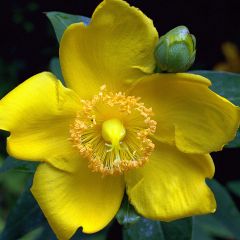
Hypericum Hidcote
- Flowering time July to November
- Height at maturity 1,50 m

Hypericum calycinum - St. John's wort
- Flowering time July to October
- Height at maturity 35 cm
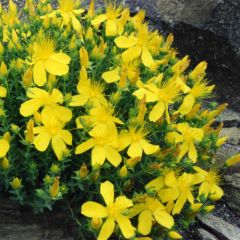
Hypericum olympicum - St. John's wort
- Flowering time June to August
- Height at maturity 35 cm
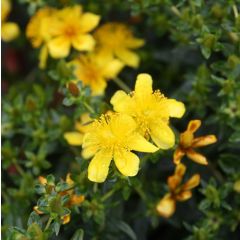
Hypericum kalmianum Gemo - St. John's wort
- Flowering time August to October
- Height at maturity 80 cm
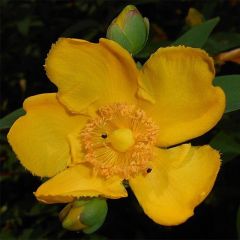
Hypericum x moserianum - St. John's wort
- Flowering time July to November
- Height at maturity 50 cm

Hypericum inodorum Magical Beauty Kolmbeau
- Flowering time July to October
- Height at maturity 90 cm
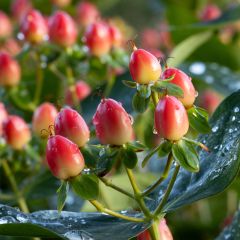
Hypericum inodorum Magical Red Flame KOLMAREF - St. John's wort
- Flowering time August to October
- Height at maturity 90 cm
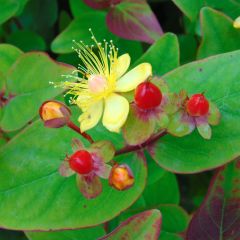
Hypericum inodorum Rheingold - St. John's wort
- Flowering time June to September
- Height at maturity 1 m

Hypericum x inodorum Magical Universe Kolmuni - St. John's wort
- Flowering time August to November
- Height at maturity 80 cm
→ To choose the right variety, follow our advice: “St John’s Wort, Hypericum: Which Variety to Choose?“
Discover other Hypericum - St.John's Wort
View all →Available in 1 sizes
Available in 1 sizes
Available in 1 sizes
Available in 1 sizes
Available in 2 sizes
Available in 1 sizes
Available in 2 sizes
Available in 1 sizes
Available in 1 sizes
Available in 1 sizes
Planting St John's Wort
Where to plant Hypericum?
Hypericum bushes grow effortlessly and won’t suffer from neglect, absence or beginner gardener mistakes. Exposed to full sun, wind, sea spray or cold – all tolerate frosts down to -15°C – they keep flowering, again and again… They can be grown in pots on terraces or balconies regardless of exposure. St John’s Wort thus fully deserves a place in all planted areas, even on slopes with poor soil.
You can create ground cover in sunny, partially shaded or even shaded spots if flowering isn’t essential, using stoloniferous species like calycinum, reptans, moserianum. Golden varieties like Golden Beacon® will however look prettier in partial shade, adding a lovely luminous touch. The plant can cover an area completely or fill spaces between bushes or perennials without causing excessive competition. Calycinum, androsaemum and ‘Hidcote’ tolerate shade well, meaning less than 4 hours of daily sunlight.
Shrubby specimens can be planted as standalone features if they reach 0.8 to 1 m tall, like H. ‘Hidcote’ or frondosum ‘Sunburst’. Less vigorous plants like ‘Gemo’, x inodorum or moserianum ‘Tricolor’ work better in perennial beds, rockeries or large containers.
The compact rounded clumps of Hypericum olympicum ‘Citrinum’, with large lemon-yellow flowers on blue-green stems, work well in dry rock gardens or for edging. It flowers from May to July.
When to plant?
Although potted St John’s Wort can be planted year-round, ideally it’s best done between October and March/April. Avoid planting during frost, extreme heat or when flowering.
How to plant?
Ground cover species like calycinum
- Weed the area then fork the soil to aerate to at least 20 cm deep.
- Add a few spadefuls of compost or organic fertiliser.
- Soak rootballs in a bucket of water then dig holes 30 cm apart for quick coverage.
- Position the collar level with the soil surface, backfill and firm around the plant. It shouldn’t come loose when tugged.
Shrubby species
Allow 40-60 cm around each young plant for even growth. For hedges, space vigorous plants 0.8-1 m apart.
- Soak the rootball to aid establishment.
- Backfill soil and firm gently.
- Water thoroughly.
- Apply mulch around the base to retain moisture and suppress weeds.
For container growing, add 3-4 cm drainage layer (gravel, pot shards etc). Use a mix of 1/3 garden soil, 1/3 compost and 1/3 coarse sand.
Maintenance and pruning
St John’s Wort is an easy bush that practically requires no maintenance.
Water during the first year to ensure proper establishment. Apply a complete fertiliser the following spring after cutting back any dried foliage. Potted young plants require more regular watering but will stop flowering if lacking water.
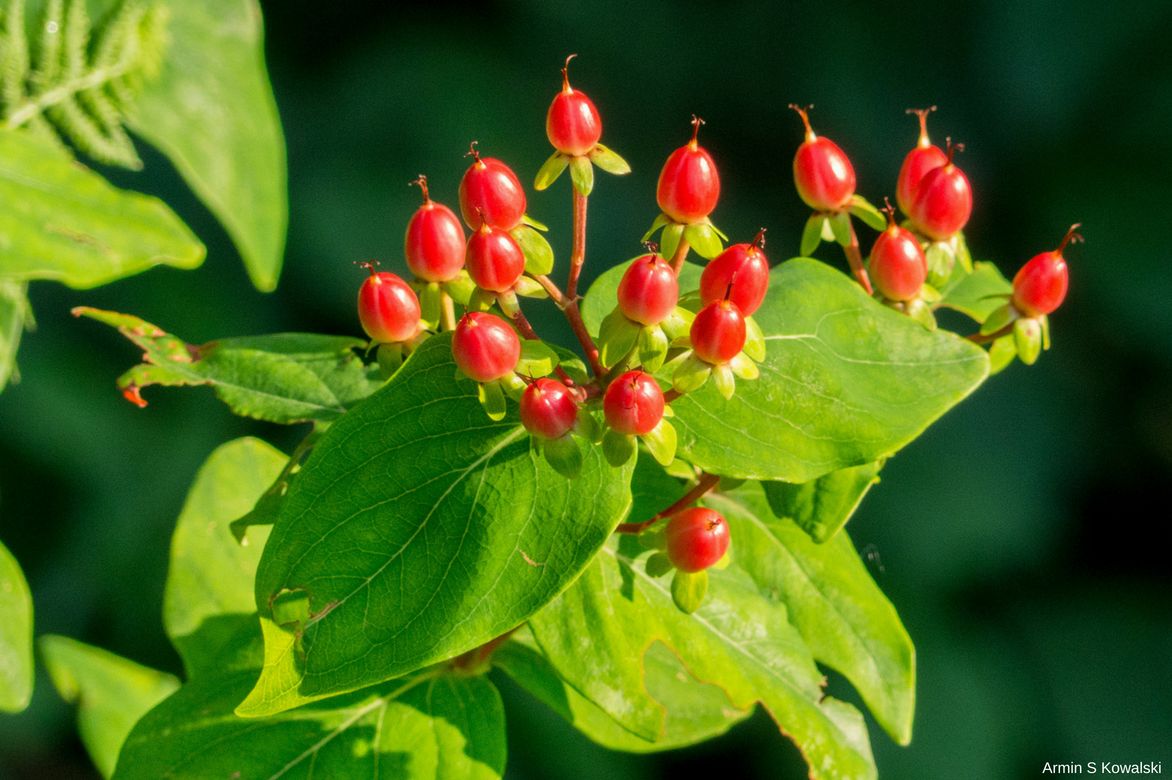
Decorative St John’s Wort berries
Pruning St John’s Wort
Dwarf (5 to 20 cm) or low-growing (30 to 50 cm) ground covers
(H. reptans, calycinum, x moserianum ‘Tricolor’)
This pruning is not obligatory but helps rejuvenate the young plant, control its spread by cutting back stolons, and maintain good density.
- Use hedge shears or secateurs once a year. Prune in late flowering in autumn for evergreen species or in late winter for deciduous species.
Shrubby species:
- Remove dead branches and those that disrupt the habit.
- Thin out occasionally with secateurs to open up the centre of the bush by cutting back half of every other branch.
- The following year, prune the remaining older branches.
- It’s also possible to cut back the entire bush completely every 5 years or so.
Potential diseases and pests
St John’s Wort may occasionally develop orange pustules on the underside of leaves. This is rust, a fungus that mainly affects forms derived from the hybrid Hypericum x inodorum (H. androsaemum X H. hircinum, found in the wild on Madeira Island). Classic St John’s Wort varieties are rarely affected, and there are resistant cultivars such as ‘Gemo’, x inodorum MAGICAL BEAUTY…
Avoid confining the young plant in damp locations, improve air circulation around the branches and prevent alternating wet and dry soil to limit the disease. Clear away pruning debris.
Propagation: propagation by cuttings, sowing, division
You can propagate St John’s Wort by sowing and propagation by cuttings. Propagation by cuttings seems to us to be the best technique, as it is simple and will produce young plants more quickly, with the assurance that they will be identical to the original variety. It is also possible to separate the stolons from running St John’s Worts.
Propagation by cuttings
Cut St John’s Wort shoots during summer and until early autumn.
- Prepare a pot by filling it with compost mixed with sand or make your cuttings directly in the ground if it is light, after aerating it with a fork, then moisten the medium.
- Take shoots about ten centimetres long from this year’s growth by cutting horizontally just below a node. They should be healthy and disease-free.
- Remove the leaves near the base of the cutting, and trim the others to reduce the foliar surface. Leave only a few leaves at the top if they haven’t fallen off.
- Make a hole in the medium using a pencil or a wooden stick.
- Place the cutting in the hole and gently firm around it to remove air pockets and ensure good contact between the compost and the cutting.
- Place the pot under a cold frame in a warm, bright spot but out of direct sunlight.
- Transplant the rooted cuttings in spring into a richer medium and grow them for at least until the following spring before planting the young plants in their final position.
Sowing
St John’s Wort is sown in autumn but you are not guaranteed to obtain the selected variety you started with.
Harvest the seeds in autumn when the fruits have turned black and separate the seeds from the pulp. Rinse the seeds before storing or sowing them.
- Prepare a pot by filling it with a special sowing compost.
- Sow the seeds by covering them with 1 cm of soil and place them under a cold frame.
- Water with a fine spray.
Continue to water regularly, but not excessively, to keep the medium moist. Repot the seedlings a few months after germination. After one or two years, you can plant them in their final location.
Division and layering
Carry out in autumn.
To divide a clump, separate the root ball with a sharp spade or cut with secateurs a stolon that has already produced roots to separate it from the mother plant.
To layer, bury a shoot from a deciduous plant, previously notched, and bring it back out a little further away. Wait at least 1 year before separating the layer from its mother plant.
→ Learn more in our tutorial: How to propagate St John’s Wort?
Use and pairing
The flowering of St John’s Wort offers various shades of yellow ranging from lemon yellow to orangey tones through to golden yellow. Avoid mixing warm yellows (calycinum, ‘Hidcote’) with cool, diffuse yellows such as those found in the foliage of x inodorum Golden Beacon or the flowers of olympicum ‘Citrinus’. These colours cancel each other out unless you add a touch of bluish-grey or dark green or stagger these hues over time. You could therefore border your Hypericum beds with Euphorbias and Lady’s Mantle, whose very flattering foliage flowers in chartreuse yellow tones much earlier.
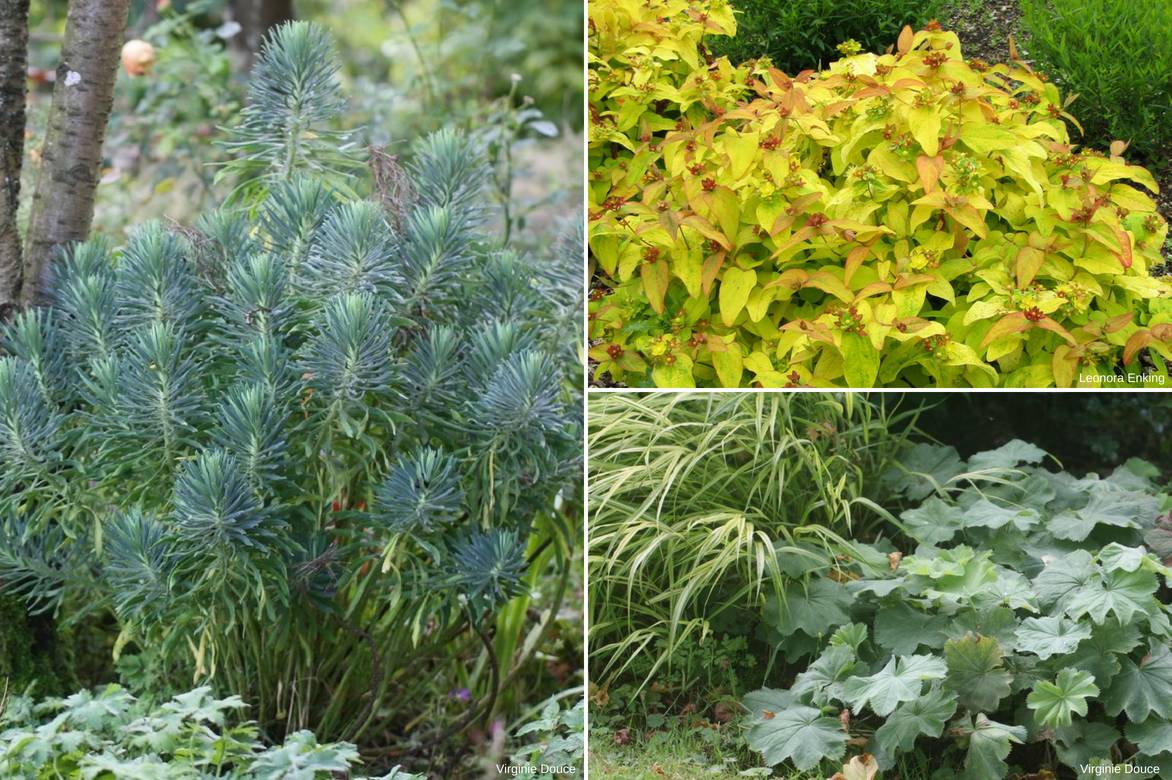

A planting idea: Hypericum ‘Golden Beacon’, Euphorbia characias ssp. wulfenii, Hakonechloa macra ‘Aureola’ and Alchemilla mollis
Golden yellow pairs well with plants of similar tones such as goldenrod (Solidago), loosestrife, Kniphofia caulescens, yarrow ‘Coronation Gold’ or Rudbeckia. Remember to vary the habit of plants to create a harmonious composition. To attenuate the brightness of yellow, which can become overwhelming, combine St John’s Wort with the blue-grey tones of a Caryopteris, Perovskia or blue chaste tree (Vitex), or with the bronze hues of purple fennel or Macleaya. The purple of a Physocarpus, Cotinus coggygria ‘Rubrifolia’ or a Berberis thunbergii ‘Admiration’ or a Phormium will create an on-trend effect.
→ Discover more planting ideas with St John’s Wort in our advice sheet.
To go further
- Discover our wide range of Hypericum: varieties for every situation
- Advice sheet: 10 summer-flowering bushes you must have in your garden
- Discover our advice sheet on St John’s Wort: herbal tea and benefits and St John’s Wort: what are its health benefits?
- Subscribe!
- Contents
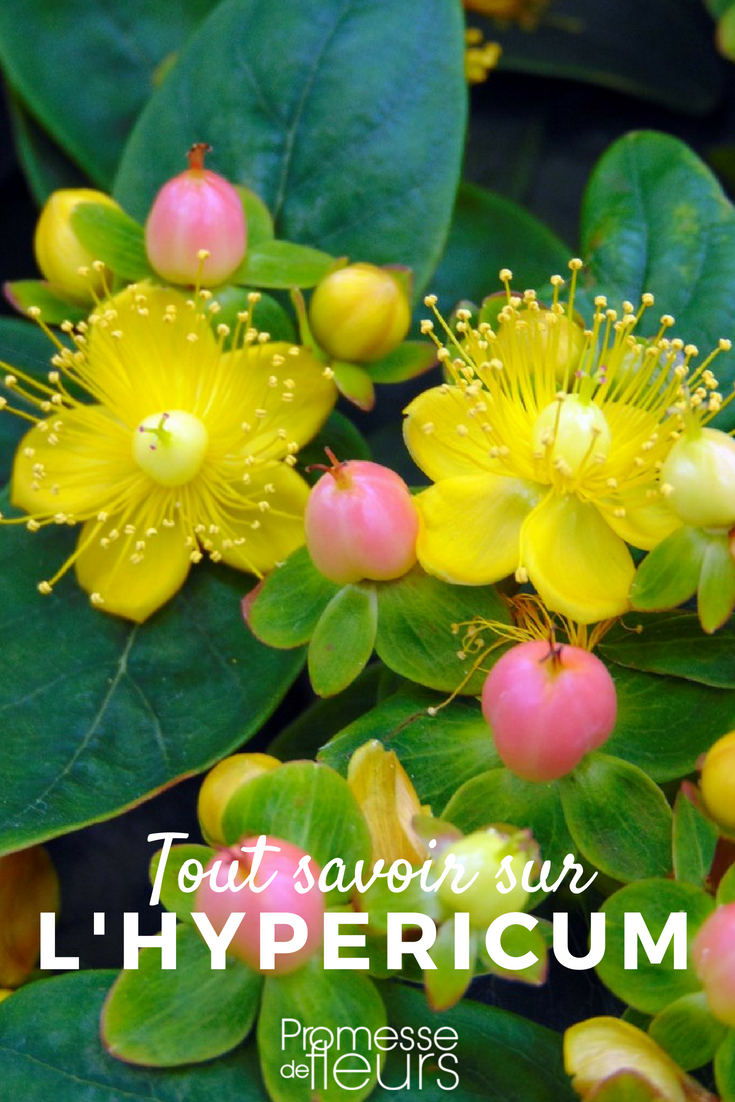

































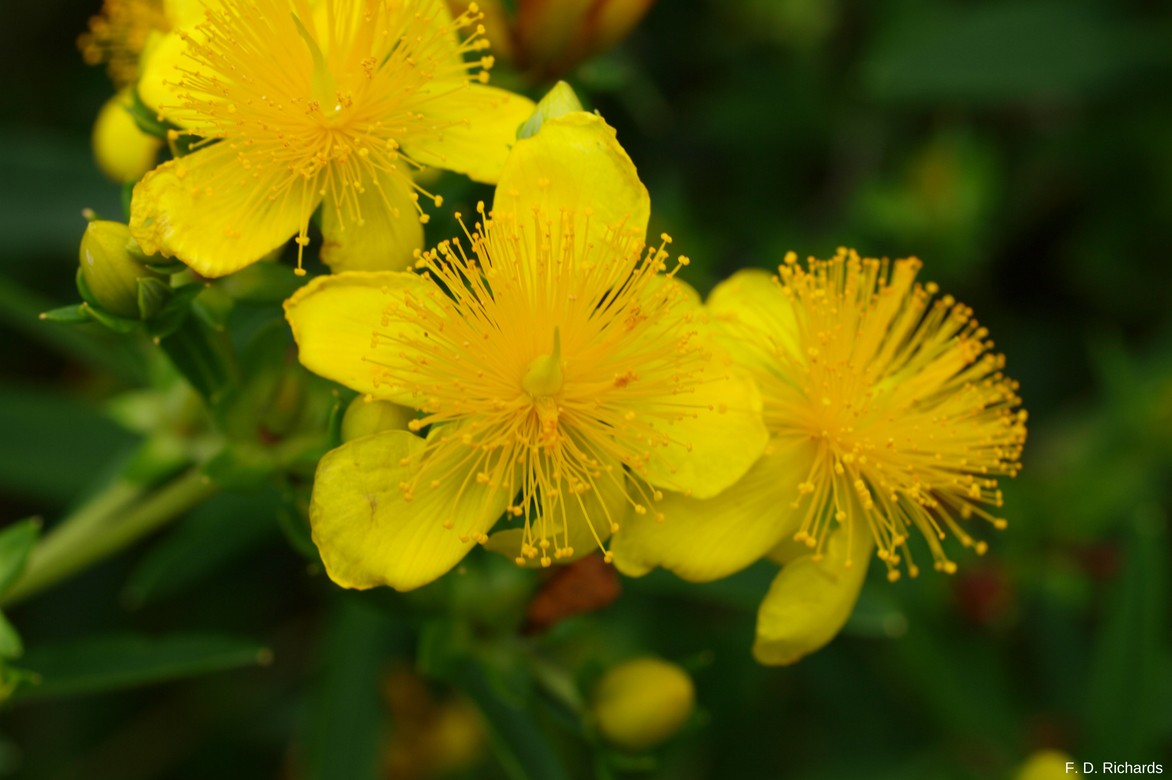

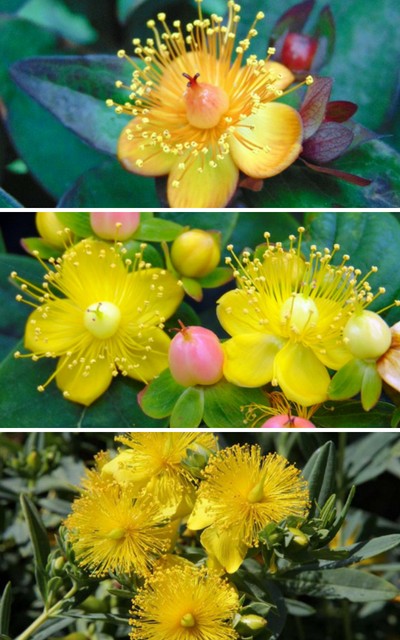
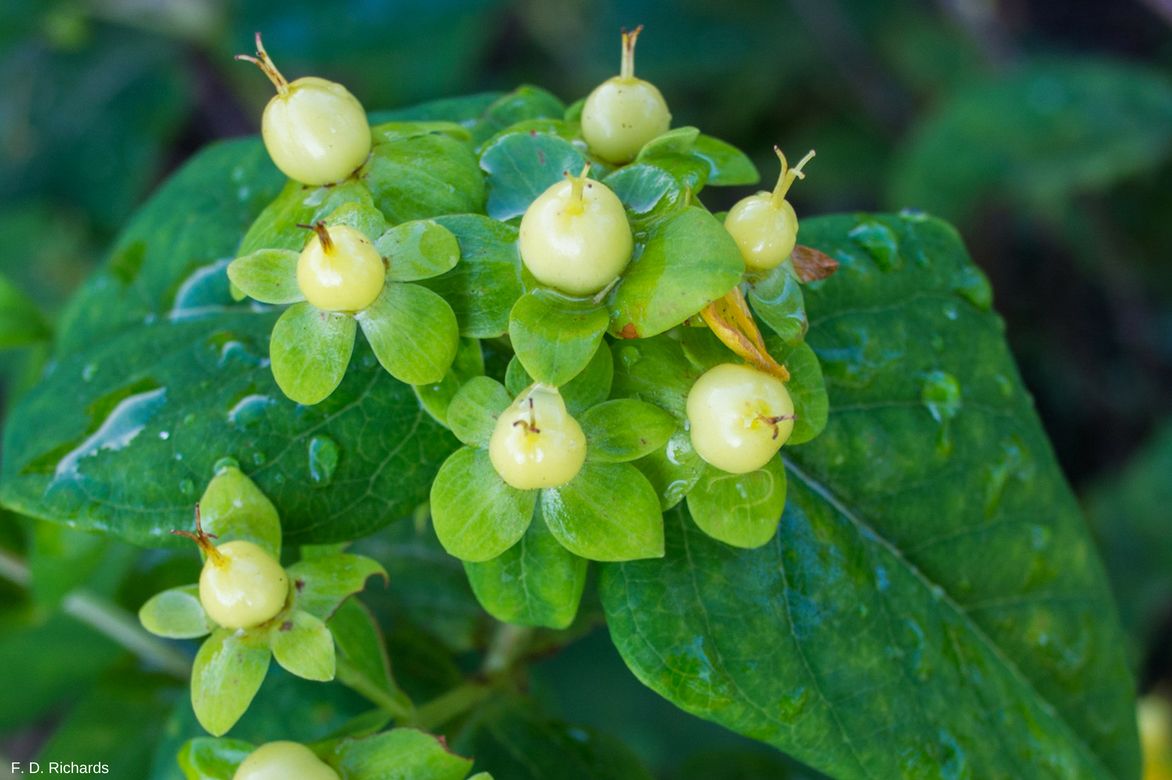


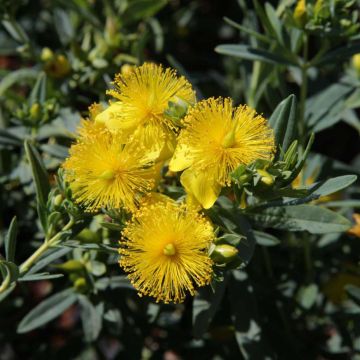

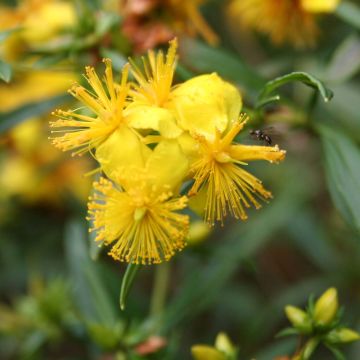

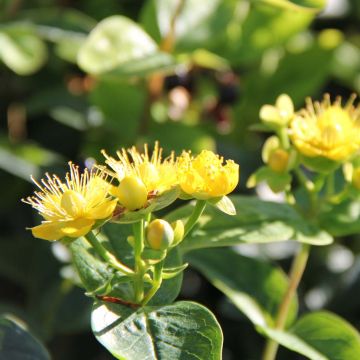
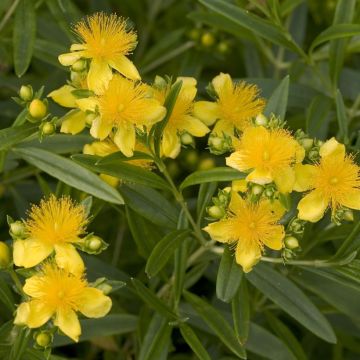
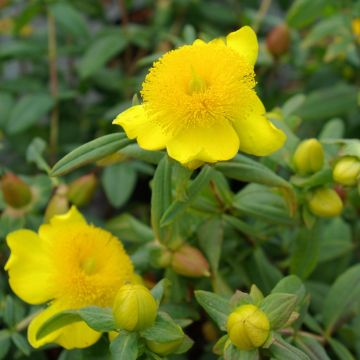
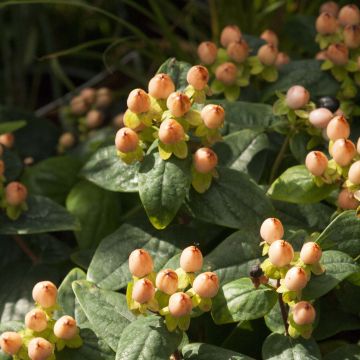
Comments